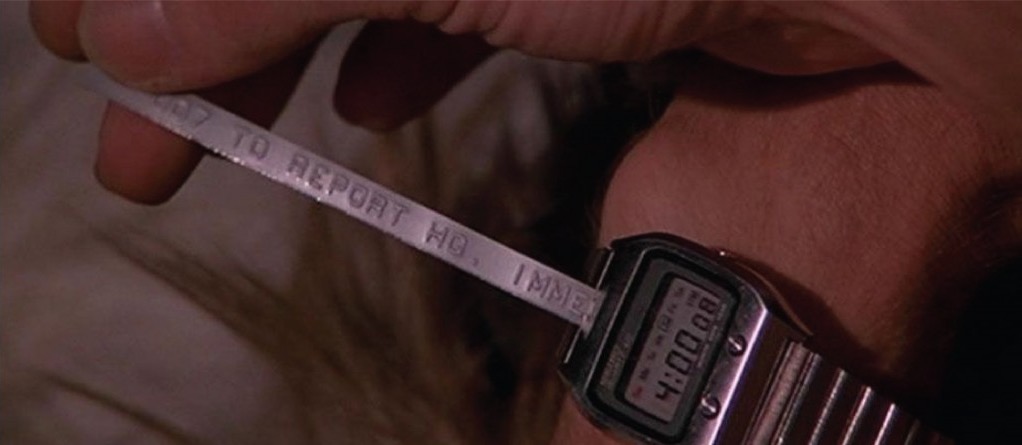By John Gruber

Kolide by 1Password ensures that if a device isn’t secure, it can’t access your apps.
Watch, Apple Watch
Thursday, 30 April 2015
When You Were Young and Your Heart Was an Open Book
Regular readers of this column are well aware of my affinity for the James Bond movies. I’ve been a fan for as long as I can remember. As a kid growing up in the late ’70s and early ’80s, I was a staunch Roger Moore fan. I loved the Connery films too, but they felt old, and as a kid, “old” is not cool. That perspective applied even to their watches. Roger Moore wore digital watches; Sean Connery wore mechanicals. Digital watches were cool; analog watches were old-fashioned.
Today, I’ve come to my senses, and I know that Connery was and always will be the definitive James Bond, and his Rolex Submariner — reference 6538 — the definitive Bond watch. The coolest of the cool. But Moore’s Bond’s digital watches were cool, too. Connery drove the most memorable Bond car, but Moore’s watches are the ones that most people think of when they think of a James Bond watch — the ones that were laden with secret gadgets. Connery’s Rolex was just a Rolex.
Look at this Pulsar from Moore’s first Bond movie, 1973’s Live and Let Die. It had a red LED display that, to preserve battery life, only turned on to display the time when you pressed a button. (Hold that thought.) And then there’s this gem — a Seiko DK001 from 1977’s The Spy Who Loved Me, which could receive secure text messages from MI6. I mean look at it:

The idea of a digital watch that can receive secure text messages was remarkably prescient. The idea that the messages would print out on ticker tape was remarkably silly. How could a device that size include a label printer? How many messages could it receive before running out of tape? Why would a spy want secret messages from headquarters printed out?1 The proper design, in hindsight, is obvious: the messages should have been displayed on screen — which is exactly how Bond’s Seiko worked in 1981’s For Your Eyes Only. And look at the design. Even the style of Apple’s link bracelet is reminiscent of that ’70s Seiko.
This is what Apple Watch is: an ambitious modern take on the digital watch.
You Know You Did, You Know You Did, You Know You Did
I’ve worn analog watches since sometime in college, and in recent years I’ve fallen hard for purely mechanical automatics. But I’ve always had, and always will have, a soft spot for digital watches. I’ve always thought watches were cool. I’ve always thought computers and electronic gadgets were cool. Digital watches exist at the intersection of these interests.
My watches as a teenager were digitals made by Casio, pretty much like this one that you can still buy today for $10: black plastic watch, resin strap, two buttons on each side. The interfaces were complex, inscrutable at first. I always knew the interfaces were bad, but I accepted them because I wanted the features. I liked having a stopwatch and countdown timer. And of course the interface was complicated: all these features were packed into a tiny little watch.
During the past four weeks, I’m surprised how much I’ve been reminded of those Casios. In the way it felt cool in 1987 to have all those features on my wrist, it feels cool today to have these features on my wrist. This is the watch my teenage 1987 self would have expected my 2015 self to own. Apple Watch’s interaction model is complicated. That doesn’t mean it’s too complicated — and I don’t think it is. There’s simply no way to avoid complexity with the number of features — which, borrowing from the terminology of the horological world, Apple is calling “complications” — Apple Watch encompasses.
Do not expect to strap on Apple Watch for the first time and feel entirely at home. It’s different, new, and surprisingly expansive. Apple Watch demands exploration. Those old Casios were arbitrary.2 Apple Watch has a logic behind its interaction design — but it needs to be used to be fully understood. The basics are obvious — initial setup and pairing with your iPhone remarkably so — but not everything. It’s a tool you have to learn to use. It is not an iPhone on your wrist.
But here’s the thing. Much of the criticism of Apple Watch is being driven by the question “Do you need an Apple Watch?” And that is simply the wrong question. It’s not useful for evaluating the watch as a product or platform, and it’s not useful to answering the question as to whether you or anyone else should buy one.
Apple Watch is not hard to understand fundamentally. It’s just a digital watch, reimagined for today’s world, where wireless networking is nearly ubiquitous, and a fully functional computer that runs all day long can be fitted in a 38mm watch case. That’s it. “Just a watch” doesn’t mean “just a timepiece”. A watch is a gadget of which timekeeping is just one possible feature. Digital watches, in particular, have always been about more than just the time and date, and Apple Watch takes this and runs with it.
It needs to justify its existence no more than any other watch — mechanical or electronic — ever made. Of course you don’t need it. No one, not one person on the face of the earth, needs any $400 watch, Apple Watch or otherwise.3
The right question is simply “Do you want one?”
It’s about desire, not necessity. Convenience, fun, and style are not needs. They’re wants. And people will gladly pay for what they want. The iPad faced similar misguided criticism. How many times did you hear or read someone say of the iPad, “Why would anyone who already has a phone and a laptop need an iPad?” That was the wrong question, because almost no one needed an iPad. The right question was “Why would someone who has a phone and laptop also want an iPad?”
In my initial review of the Apple Watch three weeks ago, I wrote:
Loosely, the path of all consumer electronic categories is to evolve as ever more computer-y gadgets, until a tipping point occurs and they turn into ever more gadget-y genuine computers. The sample size (in terms of product categories) is small, but Apple seemingly tries to enter markets at, or just after, that tipping point — when Moore’s Law and Apple’s ever-increasing engineering and manufacturing prowess allow them to produce a gadget-y computer that the computer-y gadgets from the established market leaders cannot compete with. That was the iPod. That was the iPhone.
That, they hope, is Apple Watch.
Asked about wearable devices two years ago at All Things D, Tim Cook said, “The wrist is interesting. The wrist is natural.” That Apple would make a watch, if not necessarily this watch, is the natural, dare I say inevitable result of these two factors: the wrist is a natural place for a wearable gadget, and Apple can now make a full computer with acceptable battery life4 the size of a watch.
Half the fun of the gadgets like Roger Moore’s Bond’s watches was imagining that we — regular folks in the real world — would have them in the future, alongside jetpacks and flying cars. Phone calls on our wrists. Asking our watch, verbally, what time tonight’s Yankees game starts and getting the correct answer a few moments later. But importantly: packaged not as a clumsy, homely device, but in the casing of, well, a nice, stylish watch.
If you don’t see the joy in that having come to fruition — both sides of it, the function and the style, the engineering and the design — then of course you’re not going to see the point of all the hoopla surrounding Apple Watch. And if you do see the joy in it, if you do think it’s cool that it even exists, then don’t overthink it. It’s a cool watch that does cool things.
-
In theory, Bond’s watch could have printed “secure” messages by using some sort of self-destructing ticker tape material, but everyone knows self-destructing messages from HQ are a Mission: Impossible thing. ↩︎︎
-
Here’s a user manual I found for a vintage Seiko digital watch. Not quite the same model as the one from the Bond films, but close. Download it and see how un-obvious just about everything was — from setting the time to using the stopwatch. This four-button interface is more or less how every digital watch from my youth worked. (So much so that it makes me wonder whether Casio and the rest of the industry’s digital watches were in fact rather shameless lower-priced rip-offs of Seiko’s groundbreaking designs.) ↩︎︎
-
I can imagine future scenarios, where Apple Watch functions as a true medical monitoring device (blood sugar, for example), which could justify it as a true need for many. ↩︎︎
-
A study in contrasts across the computer-y gadget/gadget-y computer inflection point: these Casio Databank watches get up to 10 years of battery life. ↩︎︎
